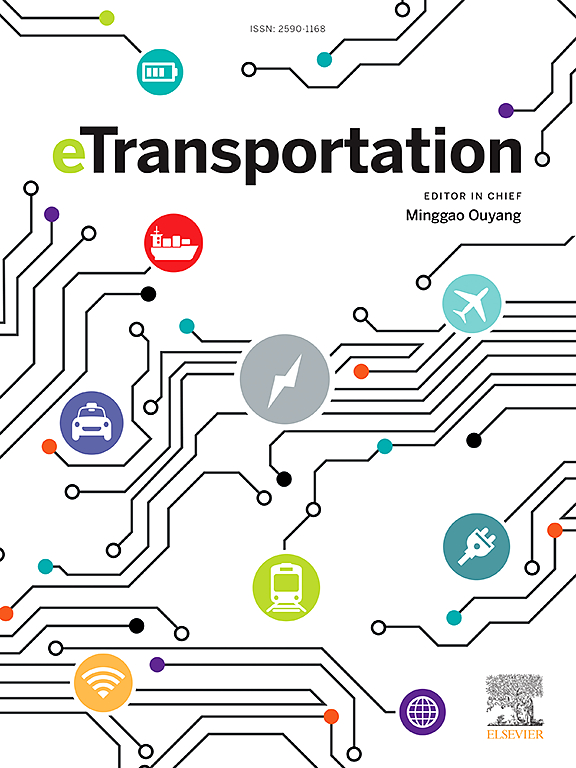锂离子电池内部热失控传播多物理场仿真及风险分析
IF 17
1区 工程技术
Q1 ENERGY & FUELS
引用次数: 0
摘要
本研究探讨了热点引发的锂离子电池内部热失控传播(TRP)机制,重点研究了TRP动力学和内部短路(ISC)与TRP前沿副反应之间的热相互作用。在内部的BatteryFOAM求解器中开发了一个集成的电-电化学-热-化学模型,结合了一个新的ISC模型,以模拟全局热失控的启动和TRP行为。建立了一个新的TRP前多区模型,分析了热传导、iscd驱动点火和副反应之间的耦合关系。结果表明,当分离器熔体失效温度(Tsep)达到最高温度梯度之前,就会发生TRP,使得ISC焦耳加热保持从热区向正常区传播的高温梯度。因此,首次引入无因次风险系数(f)来量化热量产生和耗散之间的平衡,确定f范围为1至1e5的高风险TRP前沿,阴极反应和电解质分解主导TRP加速。模型与实验的对比验证了预测的准确性。模拟表明,TRP速度为7.5 mm/s,宽度为2.8 mm,最高温度为690 K。值得注意的是,该研究首次揭示了TRP速度与热扩散系数的平方根相关,并推导了一个将速度与Tsep联系起来的方程,以指导LIB的安全实现。这项研究为设计更安全的lib提供了定量的见解,特别是在电动汽车和大规模能源存储中。本文章由计算机程序翻译,如有差异,请以英文原文为准。

Multi-physics simulation and risk analysis of internal thermal runaway propagation in lithium-ion batteries
This study investigates internal thermal runaway propagation (TRP) mechanism in lithium-ion batteries (LIBs) triggered by hotspots, focusing on the TRP dynamics and thermal interactions between internal short circuits (ISC) and side reactions within the TRP front. An integrated electrical-electrochemical-thermal-chemical model, incorporating a novel ISC model, is developed within the in-house BatteryFOAM solver to simulate global thermal runaway initiation and TRP behaviors. A new TRP front multi-zone model is built to analyze the coupling between heat conduction, ISC-driven ignition, and side reactions. The results show that the TRP occurs when the separator melt failure temperature () is reached before the maximum temperature gradient, allowing ISC Joule heating to maintain a high temperature gradient propagating from the hotspot to the normal zone. Therefore, a first-ever dimensionless risk coefficient () is introduced to quantify the balance between heat generation and dissipation, identifying high-risk TRP fronts where ranges from 1 to 1e5, with cathode reactions and electrolyte decomposition dominating TRP acceleration. Model validation against the experiments confirms the predictive accuracy. Simulations demonstrate a TRP velocity of 7.5 mm/s, a width of 2.8 mm, and a maximum temperature of 690 K. Notably, the TRP velocity is, for the first time, revealed to be correlated with the square root of the thermal diffusivity, and an equation linking velocity with is derived to guide LIB safety implementations. This study provides quantitative insights for designing safer LIBs, particularly in electric vehicles and large-scale energy storage.
求助全文
通过发布文献求助,成功后即可免费获取论文全文。
去求助
来源期刊

Etransportation
Engineering-Automotive Engineering
CiteScore
19.80
自引率
12.60%
发文量
57
审稿时长
39 days
期刊介绍:
eTransportation is a scholarly journal that aims to advance knowledge in the field of electric transportation. It focuses on all modes of transportation that utilize electricity as their primary source of energy, including electric vehicles, trains, ships, and aircraft. The journal covers all stages of research, development, and testing of new technologies, systems, and devices related to electrical transportation.
The journal welcomes the use of simulation and analysis tools at the system, transport, or device level. Its primary emphasis is on the study of the electrical and electronic aspects of transportation systems. However, it also considers research on mechanical parts or subsystems of vehicles if there is a clear interaction with electrical or electronic equipment.
Please note that this journal excludes other aspects such as sociological, political, regulatory, or environmental factors from its scope.
 求助内容:
求助内容: 应助结果提醒方式:
应助结果提醒方式:


